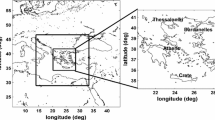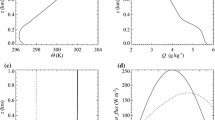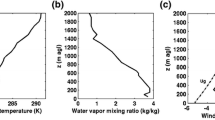Abstract
The difficulties associated with the parameterization of turbulence in the stable nocturnal planetary boundary layer (PBL) have been a great challenge for the nighttime predictions from mesoscale meteorological models such as MM5. As such, there is a general consensus on the need for better stable boundary-layer parameterizations. To this end, two new turbulence parameterizations based on the measurements of the Vertical Transport and Mixing (VTMX) field campaign were implemented and evaluated in MM5. A unique aspect of this parameterization is the use of a stability-dependent turbulent Prandtl number that allows momentum to be transported by the internal waves, while heat diffusion is impeded by the stratification. This improvement alleviates the problem of over-prediction of heat diffusion under stable conditions, which is a characteristic of conventional atmospheric boundary-layer schemes, such as the Medium Range Forecast (MRF) and Blackadar schemes employed in MM5. The predictions made with the new PBL scheme for the complex terrain airshed of Salt Lake City were compared with those made with a default scheme of MM5, and with observations made during the VTMX campaign. The new schemes showed an improvement in predictions, particularly for the nocturnal near-surface temperature. Surface wind predictions also improved slightly, but not to the extent of temperature predictions. The default MRF scheme showed a significantly higher surface temperature than observed, which could be attributed to the enhanced vertical heat exchange brought about by its turbulence parameterization. The modified parameterizations reduced the surface sensible heat flux, thus enhancing the strength of the near-surface inversion and lowering the temperature towards the observed values.
Similar content being viewed by others
References
1. Ballard S.P., Golding B.W., and Smith R.N.B., (1991), ‘Mesoscale Model Experimental Forecasts of the Haar of Northeast Scotland’. Mon. Wea. Rev. 119, 2107–2123
2. Benoit R., Cote J., and Mailhot J., (1989), ‘Inclusion of a TKE Boundary Layer Parameterization in the Canadian Regional Finite-Element Model’. Mon. Wea. Rev. 117, 1726–1750
3. Berkowicz R., Prahm L.P., (1979), ‘Generalization of K-theory for Turbulent Diffusion. Part I. Spectral Diffusivity Concept’. J. Appl. Meteorol. 18, 266–272
4. Berkowicz R., Prahm L.P., (1980), ‘On the Spectral Turbulent Diffusivity Theory for Homogeneous Turbulence’. J. Fluid Mech. 100, 433–448
Blackadar A.K., (1979), ‘High Resolution Models of the Planetary Boundary Layer’. in J. Pfafflin and E. Ziegler (eds.), Advances in Environmental Science and Engineering, Vol. 1, Gordon and Breach, pp. 50–85.
Bluemen W. (ed): 1990, ‘Atmospheric Processes Over Complex Terrain’. Meteorol. Monogr., Vol 23, No. 45, Amer. Meteorol. Soc., 323 pp.
7. Bright D.R., Mullen S.J., (2002), ‘The Sensitivity of the Numerical Simulation of the Southwest Monsoon Boundary Layer to the Choice of PBL Turbulence Parameterization in MM5’. Wea. Forecast. 17, 99–114
8. Brown A.R., Derbyshire, S H., and Mason P.J., (1994), ‘Large Eddy Simulation of Stable Atmospheric Boundary Layers with a Revised Stochastic Subgrid Model’. Quart. J. Roy. Meteorol. Soc. 120, 1485–1512
9. Chen F., Dudhia J., (2001), ‘Coupling an Advanced Land-Surface/Hydrology Model with the Penn State/NCAR MM5 Modeling System. Part I: Model Implementation and Sensitivity’. Mon. Wea. Rev. 129, 569–585
10. Corrsin S., (1974), ‘Limitations of Gradient Transport Models in Random Walks and in Turbulence’. Adv. Geophys. 18A, 25–60
11. Derbyshire S.H., (1999), ‘Stable Boundary-Layer Modeling: Established Approaches and Beyond’. Boundary-Layer Meteorol. 90, 423–446
12. Doran J.C., Fast J.D., and Horel J., (2002), ‘The VTMX 2000 Campaign’. Bull. Amer. Meteorol. Soc. 83, 537–551
13. Estoque M.A., (1968), ‘Vertical Mixing due to Penetrative Convection’. J. Atmos. Sci. 25, 1046–1051
Fernando H.J.S., (2002), ‘Turbulence in Stratified Flows’. in R. Grimshaw (ed.), Environmental Stratified Flows, Kluwer Publishing, pp. 163–192.
15. Fernando H.J.S., (2003), ‘Turbulence Patches in a Stratified Shear Flow’. Phys. Fluids. 15(10): 3164–3169
16. Fiedler B.H., (1984), ‘An Integral Closure Model for the Vertical Turbulent Flux of a Scalar in a Mixed Layer’. J. Atmos. Sci. 41, 674–680
17. Gargett A.E., Holloway G., (1992), ‘Sensitivity of the GFDL Ocean Model to Different Diffusivities for Heat and Salt’. J. Phys. Oceanogr. 22, 1158–1177
Grell G.A., Dudhia J., and Stauffer D.R., (1995), Fifth-generation Penn State/NCAR Mesoscale Model (MM5), NCAR Technical note, NCAR/TN-398 + STR. (Available on internet, http://box.mmm.ucar.edu/mm5/documents/mm5-desc-pdf/).
19. Holtslag A.A.M., Moeng C.-H., (1991), ‘Eddy Diffusivity and Countergradient Transport in the Convective Atmospheric Boundary Layer’. J. Atmos. Sci. 48, 1690–1698
20. Hong S.-Y., Pan H.-L., (1996), ‘Nonlocal Boundary Layer Vertical Diffusion in a Medium-Range Forecast Model’. Mon. Wea. Rev. 124, 2322–2339
21. Janjic Z.I., (1990), ‘The Step-Mountain Coordinate: Physical Package’. Mon Wea. Rev. 118, 1429–1443
22. Janjic Z.I., (1994), ‘The Step-Mountain Eta Coordinate Model: Further Developments of the Convection, Viscous Sublayer, and Turbulence Closure Schemes’. Mon. Wea. Rev. 122, 927–945
23. Lee S.M., Fernando H.J.S., (2004), ‘Evaluation of Mesoscale Meteorological Models, MM5 and HOTMAC Using PAFEX-I Data’. J. Appl. Meteorol. 43, 1133–1148
24. Louis J.F., (1979), ‘A Parametric Model of Vertical Eddy Fluxes in the Atmosphere’. Boundary-Layer Meteorol. 54, 187–202
25. Mahrt L., Sun J., Blumen W., Delany T., and Oncley S., (1999), ‘Nocturnal Boundary-Layer Regimes’. Boundary-Layer Meteorol. 88, 255–278
26. McNider R.T., England D.E., Friedman M.J., and Shi X., (1995), ‘Predictability of the Stable Atmospheric Boundary Layer’. J. Atmos. Sci. 52, 1602–1614
27. Mellor G.L., Yamada T., (1974), ‘A Hierarchy of Turbulence Closure Models for Planetary Boundary Layers’. J. Atmos. Sci. 31, 1791–1806
28. Monti P., Fernando H.J.S., Princevac M., Chan W.C., Kowalewski T.A., and Pardyjak E.R., (2002), ‘Observations of Flow and Turbulence in the Nocturnal Boundary Layer Over a Slope’. J. Atmos. Sci. 59, 2513–2534
29. Nieuwstadt F. T. M., (1984), ‘The Turbulent Structure of the Stable, Nocturnal Boundary Layer’. J. Atmos. Sci. 41, 2202–2216
30. Pan Z., Benjamin S., Brown J.M., and Smirnova T., (1994), ‘Comparative Experiments with MAPS on Different Parameterization Schemes for Surface Moisture Flux and Boundary Layer Processes’. Mon. Wea. Rev. 122, 449–470
31. Pacanowski R.C., Philander S.G.H., (1981), ‘Parameterization of Vertical Mixing in Numerical Models of the Tropical Oceans’. J. Phys. Oceanogr. 11, 1443–1451
Pielke R.A., Pearce R.P., (1994), Mesoscale Modeling of the Atmosphere, Meteorol. Monogr., Vol 25, No. 47, Amer. Meteorol. Soc., 156 pp.
33. Poulos G.S., Blumen W., Fritts D.C., Lundquist J., Sun J., Burns S.P., Nappo C., Banta R., Newsom R., Cuxart J., Terradellas E., Balsley B., and Jensen M., (2002), ‘CASES-99: A Comprehensive Investigation of the Stable Nocturnal Boundary Layer’. Bull. Amer. Meteorol. Soc. 83, 521–536
34. Riley J.J., Lelong M.P., (2000), ‘Fluid Motions in the Presence of Strong Stable Stratification’. Ann. Rev. Fluid Mech. 32, 613–657
35. Rotach M.W., others (2004), ‘Turbulence Structure and Exchange Processes in an Alpine Valley: The Riviera Project’. Bull. Amer. Meteorol. Soc. 85, 1367–1385
36. Sivacoumar R., Thanasekaran K., (2001), ‘Comparison and Performance Evaluation of Models Used for Vehicular Pollution Prediction’. J. Environ. Eng. 127, 524–530
37. Strang E.J., Fernando H.J.S., (2001), ‘Vertical Mixing and Transports Through a Stratified Shear Layer’. J. Phys. Oceanogr. 31, 2026–2048
38. Stull R.B., (1988), An Introduction to Boundary Layer Meteorology. Kluwer Academic Publishers, Dordrecht, 666 pp
39. Stull R.B., (1993), ‘Review of Non-Local Mixing in Turbulent Atmospheres: Transilient Turbulence Theory’. Boundary-Layer Meteorol. 62, 21–96
40. Townsend A.A., (1980), The Structure of Turbulent Shear Flow. Cambridge University Press, UK., 440 pp
41. Troen I., Mahrt L., (1986), ‘A Simple Model of the Atmospheric Boundary Layer: Sensitivity to Surface Evaporation’. Boundary-Layer Meteorol. 37, 129–148
42. Whiteman C.D., (2000), Mountain Meteorology: Fundamentals and Applications. Oxford University Press, UK., 355 pp
43. Wyngaard J.C., Brost R.A., (1984), ‘Top-Down and Bottom-Up Diffusion of a Scalar in the Convective Boundary Layer’. J. Atmos. Sci. 41, 102–112
44. Xiu A., Pleim J.E., (2000), ‘Development of a Land Surface Model. Part I: Application in a Mesoscale Meteorology Model’. J. Appl. Meteorol. 40, 192–209
45. Yamada T., (1983), ‘Simulations of Nocturnal Drainage Flows by a q2l Turbulence Closuer Model’. J. Atmos. Sci. 40, 91–106
46. Yamada T., Bunker S., (1988), ‘Development of a Nested Grid, Second Moment Turbulence Closure Model and Application to the 1982 ASCOT Brush Creek Data Simulation’. J. Appl. Meteorol. 27, 562–578
47. Zhang D., Anthes R.A., (1982), ‘A High-Resolution Model of the Planetary Boundary Layer – Sensitivity Tests and Comparisons with SESAME-79 Data’. J. Appl. Meteorol. 21, 1594–1609
48. Zhang D.-L., Zheng W.-Z., (2004), ‘Diurnal Cycle of Surface Winds and Temperature as Simulated by Five Boundary Layer Parameterizations’. J. Appl. Meteorol. 43, 157–169
49. Zhong S., Fast J., (2003), ‘An Evaluation of MM5, RAMS, and Meso Eta at Sub-Kilometer Resolution using VTMX Field Campaign Data in the Salt Lake Valley’. Mon. Wea. Rev. 131, 1301–1322
Author information
Authors and Affiliations
Corresponding author
Rights and permissions
About this article
Cite this article
Lee, SM., Giori, W., Princevac, M. et al. Implementation of a Stable PBL Turbulence Parameterization for the Mesoscale Model MM5: Nocturnal Flow in Complex Terrain. Boundary-Layer Meteorol 119, 109–134 (2006). https://doi.org/10.1007/s10546-005-9018-4
Received:
Accepted:
Published:
Issue Date:
DOI: https://doi.org/10.1007/s10546-005-9018-4




